Nikos Kolotouros
Instant 3D Human Avatar Generation using Image Diffusion Models
Jun 11, 2024
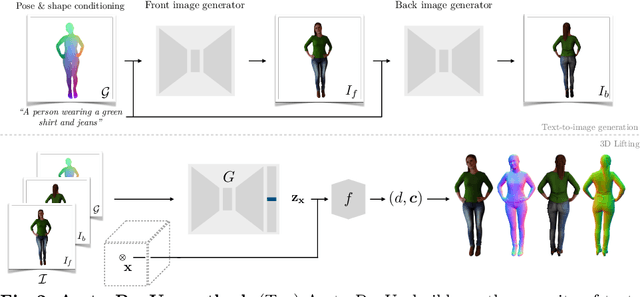

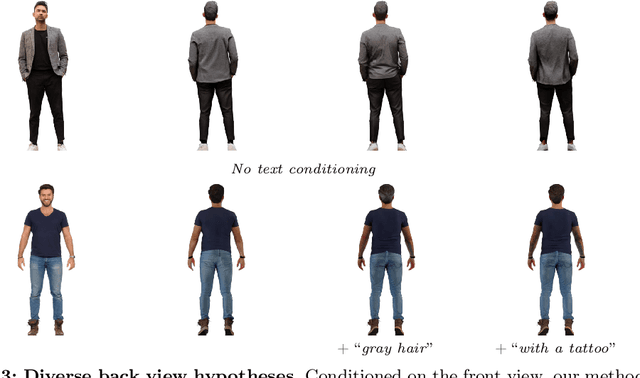
Abstract:We present AvatarPopUp, a method for fast, high quality 3D human avatar generation from different input modalities, such as images and text prompts and with control over the generated pose and shape. The common theme is the use of diffusion-based image generation networks that are specialized for each particular task, followed by a 3D lifting network. We purposefully decouple the generation from the 3D modeling which allow us to leverage powerful image synthesis priors, trained on billions of text-image pairs. We fine-tune latent diffusion networks with additional image conditioning to solve tasks such as image generation and back-view prediction, and to support qualitatively different multiple 3D hypotheses. Our partial fine-tuning approach allows to adapt the networks for each task without inducing catastrophic forgetting. In our experiments, we demonstrate that our method produces accurate, high-quality 3D avatars with diverse appearance that respect the multimodal text, image, and body control signals. Our approach can produce a 3D model in as few as 2 seconds, a four orders of magnitude speedup w.r.t. the vast majority of existing methods, most of which solve only a subset of our tasks, and with fewer controls, thus enabling applications that require the controlled 3D generation of human avatars at scale. The project website can be found at https://www.nikoskolot.com/avatarpopup/.
DiffHuman: Probabilistic Photorealistic 3D Reconstruction of Humans
Mar 30, 2024


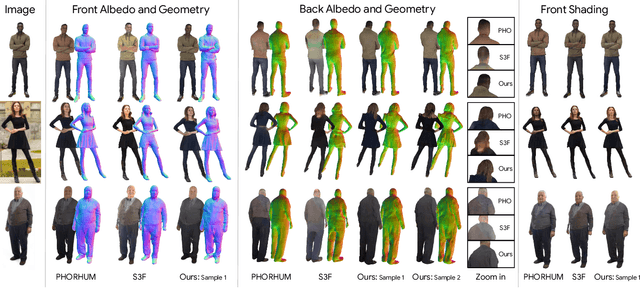
Abstract:We present DiffHuman, a probabilistic method for photorealistic 3D human reconstruction from a single RGB image. Despite the ill-posed nature of this problem, most methods are deterministic and output a single solution, often resulting in a lack of geometric detail and blurriness in unseen or uncertain regions. In contrast, DiffHuman predicts a probability distribution over 3D reconstructions conditioned on an input 2D image, which allows us to sample multiple detailed 3D avatars that are consistent with the image. DiffHuman is implemented as a conditional diffusion model that denoises pixel-aligned 2D observations of an underlying 3D shape representation. During inference, we may sample 3D avatars by iteratively denoising 2D renders of the predicted 3D representation. Furthermore, we introduce a generator neural network that approximates rendering with considerably reduced runtime (55x speed up), resulting in a novel dual-branch diffusion framework. Our experiments show that DiffHuman can produce diverse and detailed reconstructions for the parts of the person that are unseen or uncertain in the input image, while remaining competitive with the state-of-the-art when reconstructing visible surfaces.
VLOGGER: Multimodal Diffusion for Embodied Avatar Synthesis
Mar 13, 2024Abstract:We propose VLOGGER, a method for audio-driven human video generation from a single input image of a person, which builds on the success of recent generative diffusion models. Our method consists of 1) a stochastic human-to-3d-motion diffusion model, and 2) a novel diffusion-based architecture that augments text-to-image models with both spatial and temporal controls. This supports the generation of high quality video of variable length, easily controllable through high-level representations of human faces and bodies. In contrast to previous work, our method does not require training for each person, does not rely on face detection and cropping, generates the complete image (not just the face or the lips), and considers a broad spectrum of scenarios (e.g. visible torso or diverse subject identities) that are critical to correctly synthesize humans who communicate. We also curate MENTOR, a new and diverse dataset with 3d pose and expression annotations, one order of magnitude larger than previous ones (800,000 identities) and with dynamic gestures, on which we train and ablate our main technical contributions. VLOGGER outperforms state-of-the-art methods in three public benchmarks, considering image quality, identity preservation and temporal consistency while also generating upper-body gestures. We analyze the performance of VLOGGER with respect to multiple diversity metrics, showing that our architectural choices and the use of MENTOR benefit training a fair and unbiased model at scale. Finally we show applications in video editing and personalization.
Score Distillation Sampling with Learned Manifold Corrective
Jan 10, 2024



Abstract:Score Distillation Sampling (SDS) is a recent but already widely popular method that relies on an image diffusion model to control optimization problems using text prompts. In this paper, we conduct an in-depth analysis of the SDS loss function, identify an inherent problem with its formulation, and propose a surprisingly easy but effective fix. Specifically, we decompose the loss into different factors and isolate the component responsible for noisy gradients. In the original formulation, high text guidance is used to account for the noise, leading to unwanted side effects. Instead, we train a shallow network mimicking the timestep-dependent denoising deficiency of the image diffusion model in order to effectively factor it out. We demonstrate the versatility and the effectiveness of our novel loss formulation through several qualitative and quantitative experiments, including optimization-based image synthesis and editing, zero-shot image translation network training, and text-to-3D synthesis.
DreamHuman: Animatable 3D Avatars from Text
Jun 15, 2023



Abstract:We present DreamHuman, a method to generate realistic animatable 3D human avatar models solely from textual descriptions. Recent text-to-3D methods have made considerable strides in generation, but are still lacking in important aspects. Control and often spatial resolution remain limited, existing methods produce fixed rather than animated 3D human models, and anthropometric consistency for complex structures like people remains a challenge. DreamHuman connects large text-to-image synthesis models, neural radiance fields, and statistical human body models in a novel modeling and optimization framework. This makes it possible to generate dynamic 3D human avatars with high-quality textures and learned, instance-specific, surface deformations. We demonstrate that our method is capable to generate a wide variety of animatable, realistic 3D human models from text. Our 3D models have diverse appearance, clothing, skin tones and body shapes, and significantly outperform both generic text-to-3D approaches and previous text-based 3D avatar generators in visual fidelity. For more results and animations please check our website at https://dream-human.github.io.
TAPE: Temporal Attention-based Probabilistic human pose and shape Estimation
Apr 29, 2023Abstract:Reconstructing 3D human pose and shape from monocular videos is a well-studied but challenging problem. Common challenges include occlusions, the inherent ambiguities in the 2D to 3D mapping and the computational complexity of video processing. Existing methods ignore the ambiguities of the reconstruction and provide a single deterministic estimate for the 3D pose. In order to address these issues, we present a Temporal Attention based Probabilistic human pose and shape Estimation method (TAPE) that operates on an RGB video. More specifically, we propose to use a neural network to encode video frames to temporal features using an attention-based neural network. Given these features, we output a per-frame but temporally-informed probability distribution for the human pose using Normalizing Flows. We show that TAPE outperforms state-of-the-art methods in standard benchmarks and serves as an effective video-based prior for optimization-based human pose and shape estimation. Code is available at: https: //github.com/nikosvasilik/TAPE
Probabilistic Modeling for Human Mesh Recovery
Aug 26, 2021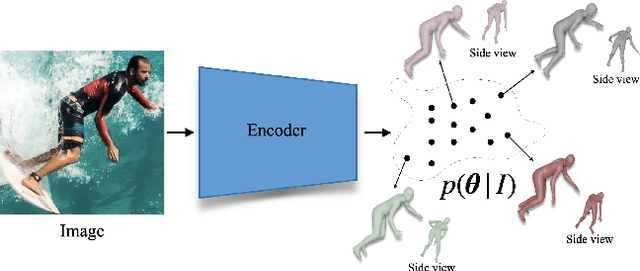
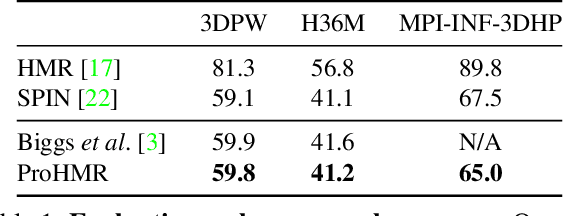
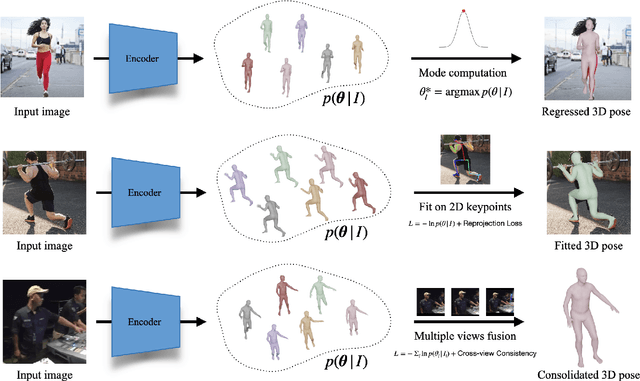
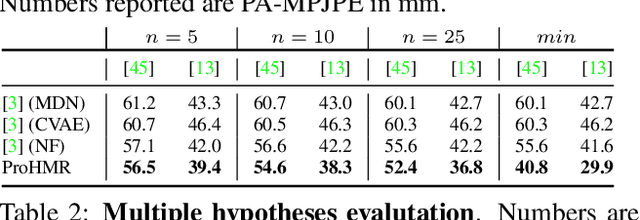
Abstract:This paper focuses on the problem of 3D human reconstruction from 2D evidence. Although this is an inherently ambiguous problem, the majority of recent works avoid the uncertainty modeling and typically regress a single estimate for a given input. In contrast to that, in this work, we propose to embrace the reconstruction ambiguity and we recast the problem as learning a mapping from the input to a distribution of plausible 3D poses. Our approach is based on the normalizing flows model and offers a series of advantages. For conventional applications, where a single 3D estimate is required, our formulation allows for efficient mode computation. Using the mode leads to performance that is comparable with the state of the art among deterministic unimodal regression models. Simultaneously, since we have access to the likelihood of each sample, we demonstrate that our model is useful in a series of downstream tasks, where we leverage the probabilistic nature of the prediction as a tool for more accurate estimation. These tasks include reconstruction from multiple uncalibrated views, as well as human model fitting, where our model acts as a powerful image-based prior for mesh recovery. Our results validate the importance of probabilistic modeling, and indicate state-of-the-art performance across a variety of settings. Code and models are available at: https://www.seas.upenn.edu/~nkolot/projects/prohmr.
Birds of a Feather: Capturing Avian Shape Models from Images
May 19, 2021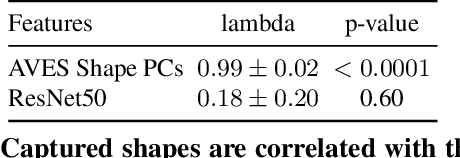



Abstract:Animals are diverse in shape, but building a deformable shape model for a new species is not always possible due to the lack of 3D data. We present a method to capture new species using an articulated template and images of that species. In this work, we focus mainly on birds. Although birds represent almost twice the number of species as mammals, no accurate shape model is available. To capture a novel species, we first fit the articulated template to each training sample. By disentangling pose and shape, we learn a shape space that captures variation both among species and within each species from image evidence. We learn models of multiple species from the CUB dataset, and contribute new species-specific and multi-species shape models that are useful for downstream reconstruction tasks. Using a low-dimensional embedding, we show that our learned 3D shape space better reflects the phylogenetic relationships among birds than learned perceptual features.
3D Bird Reconstruction: a Dataset, Model, and Shape Recovery from a Single View
Aug 13, 2020



Abstract:Automated capture of animal pose is transforming how we study neuroscience and social behavior. Movements carry important social cues, but current methods are not able to robustly estimate pose and shape of animals, particularly for social animals such as birds, which are often occluded by each other and objects in the environment. To address this problem, we first introduce a model and multi-view optimization approach, which we use to capture the unique shape and pose space displayed by live birds. We then introduce a pipeline and experiments for keypoint, mask, pose, and shape regression that recovers accurate avian postures from single views. Finally, we provide extensive multi-view keypoint and mask annotations collected from a group of 15 social birds housed together in an outdoor aviary. The project website with videos, results, code, mesh model, and the Penn Aviary Dataset can be found at https://marcbadger.github.io/avian-mesh.
Coherent Reconstruction of Multiple Humans from a Single Image
Jun 15, 2020
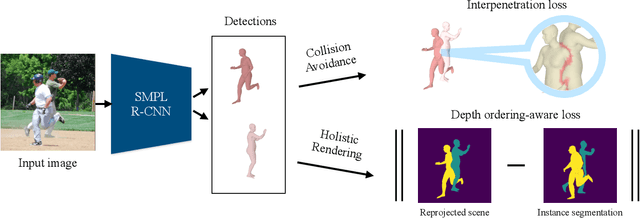

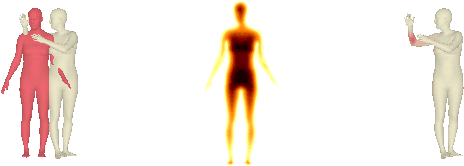
Abstract:In this work, we address the problem of multi-person 3D pose estimation from a single image. A typical regression approach in the top-down setting of this problem would first detect all humans and then reconstruct each one of them independently. However, this type of prediction suffers from incoherent results, e.g., interpenetration and inconsistent depth ordering between the people in the scene. Our goal is to train a single network that learns to avoid these problems and generate a coherent 3D reconstruction of all the humans in the scene. To this end, a key design choice is the incorporation of the SMPL parametric body model in our top-down framework, which enables the use of two novel losses. First, a distance field-based collision loss penalizes interpenetration among the reconstructed people. Second, a depth ordering-aware loss reasons about occlusions and promotes a depth ordering of people that leads to a rendering which is consistent with the annotated instance segmentation. This provides depth supervision signals to the network, even if the image has no explicit 3D annotations. The experiments show that our approach outperforms previous methods on standard 3D pose benchmarks, while our proposed losses enable more coherent reconstruction in natural images. The project website with videos, results, and code can be found at: https://jiangwenpl.github.io/multiperson
 Add to Chrome
Add to Chrome Add to Firefox
Add to Firefox Add to Edge
Add to Edge